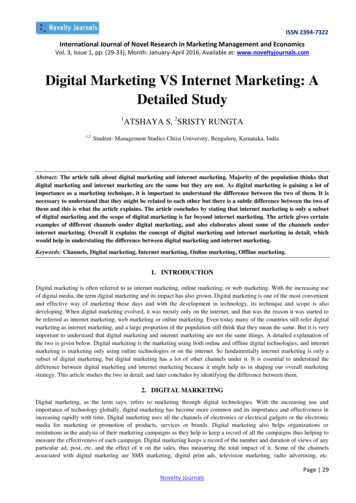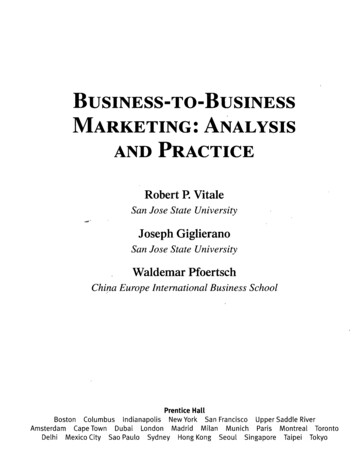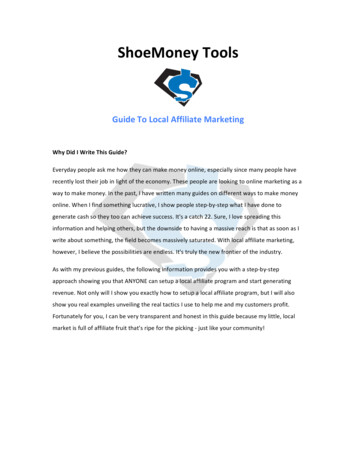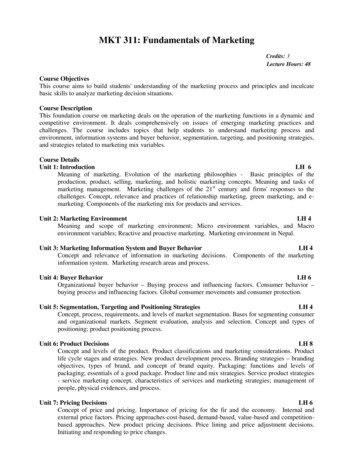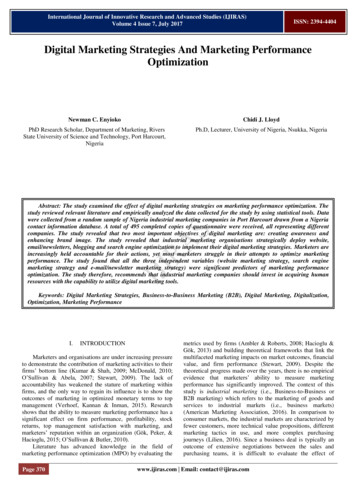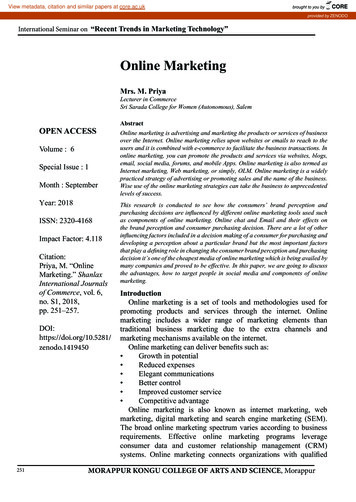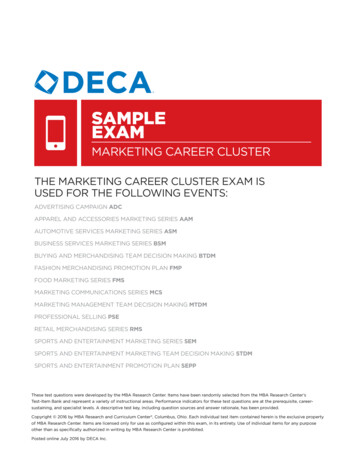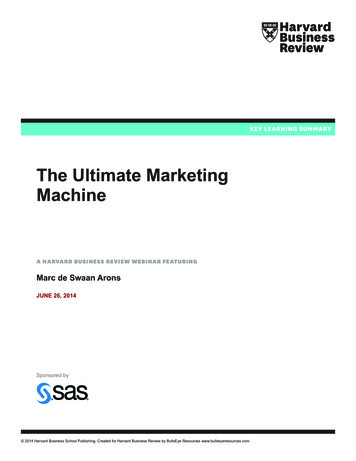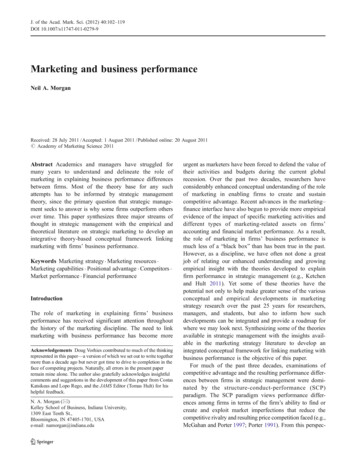
Transcription
J. of the Acad. Mark. Sci. (2012) 40:102–119DOI 10.1007/s11747-011-0279-9Marketing and business performanceNeil A. MorganReceived: 28 July 2011 / Accepted: 1 August 2011 / Published online: 20 August 2011# Academy of Marketing Science 2011Abstract Academics and managers have struggled formany years to understand and delineate the role ofmarketing in explaining business performance differencesbetween firms. Most of the theory base for any suchattempts has to be informed by strategic managementtheory, since the primary question that strategic management seeks to answer is why some firms outperform othersover time. This paper synthesizes three major streams ofthought in strategic management with the empirical andtheoretical literature on strategic marketing to develop anintegrative theory-based conceptual framework linkingmarketing with firms’ business performance.Keywords Marketing strategy . Marketing resources .Marketing capabilities . Positional advantage . Competitors .Market performance . Financial performanceIntroductionThe role of marketing in explaining firms’ businessperformance has received significant attention throughoutthe history of the marketing discipline. The need to linkmarketing with business performance has become moreAcknowledgements Doug Vorhies contributed to much of the thinkingrepresented in this paper—a version of which we set out to write togethermore than a decade ago but never got time to drive to completion in theface of competing projects. Naturally, all errors in the present paperremain mine alone. The author also gratefully acknowledges insightfulcomments and suggestions in the development of this paper from CostasKatsikeas and Lopo Rego, and the JAMS Editor (Tomas Hult) for hishelpful feedback.N. A. Morgan (*)Kelley School of Business, Indiana University,1309 East Tenth St.,Bloomington, IN 47405-1701, USAe-mail: namorgan@indiana.eduurgent as marketers have been forced to defend the value oftheir activities and budgets during the current globalrecession. Over the past two decades, researchers haveconsiderably enhanced conceptual understanding of the roleof marketing in enabling firms to create and sustaincompetitive advantage. Recent advances in the marketing–finance interface have also begun to provide more empiricalevidence of the impact of specific marketing activities anddifferent types of marketing-related assets on firms’accounting and financial market performance. As a result,the role of marketing in firms’ business performance ismuch less of a “black box” than has been true in the past.However, as a discipline, we have often not done a greatjob of relating our enhanced understanding and growingempirical insight with the theories developed to explainfirm performance in strategic management (e.g., Ketchenand Hult 2011). Yet some of these theories have thepotential not only to help make greater sense of the variousconceptual and empirical developments in marketingstrategy research over the past 25 years for researchers,managers, and students, but also to inform how suchdevelopments can be integrated and provide a roadmap forwhere we may look next. Synthesizing some of the theoriesavailable in strategic management with the insights available in the marketing strategy literature to develop anintegrated conceptual framework for linking marketing withbusiness performance is the objective of this paper.For much of the past three decades, examinations ofcompetitive advantage and the resulting performance differences between firms in strategic management were dominated by the structure-conduct-performance (SCP)paradigm. The SCP paradigm views performance differences among firms in terms of the firm’s ability to find orcreate and exploit market imperfections that reduce thecompetitive rivalry and resulting price competition faced (e.g.,McGahan and Porter 1997; Porter 1991). From this perspec-
J. of the Acad. Mark. Sci. (2012) 40:102–119tive, business performance is fundamentally driven by thedegree of competition in the marketplaces in which the firmchooses to operate, which in turn is a function of thestructural characteristics of those marketplaces. Superiorbusiness performance is therefore achieved (1) by investingin markets low in competitive rivalry and (2) through gainingpositional advantages within these markets that can besustained through the creation and exploitation of marketimperfections that limit competition (Porter 1980, 1985). Thefocus of strategy formation from the SCP perspectivetherefore centers on industry analysis and market selection(Teece et al. 1997), and this has been reflected in themultiplicity of tools of external analysis developed bystrategic marketing academics and consultants.Over the past 15 years however, the SCP approach hasbeen challenged by the resource-based view (RBV), whichviews firm-specific resources rather than market characteristics as the cornerstone of competitive advantage and firmperformance (e.g., Conner 1991; Peteraf 1993; Wernerfelt1984). From this perspective, firms are idiosyncratic andsomewhat “sticky” bundles of resources, with resourceheterogeneity creating differences in each firm’s ability toconceive of and execute particular value-creating strategieswhich in turn lead to inter-firm performance differences (e.g.,Amit and Shoemaker 1993; Miller and Shamsie 1996). Oncea firm has effectively deployed its resources, any resultingcompetitive advantage is sustained by the inability of othersto substitute or imitate the firm-specific combination ofresources on which the firm’s strategy is based (Mahoneyand Pandian 1992; Penrose 1959). The focus of strategyformation within the RBV is, therefore, the identification ofkey resources and the deployment of those firm-specificresources in markets where the greatest rent-earning potentialexists (Amit and Shoemaker 1993; Grant 1991).In turn, the RBV has been the subject of increasinglycritical theoretical attention within strategic management.Most notably, critics have highlighted weaknesses in RBVtheory’s inability to explain how resources are developedand deployed to achieve competitive advantage (e.g., Priemand Butler 2001) and its failure to consider the impact ofdynamic market environments (e.g., Lengnick-Hall andWolff 1999). In dealing with these weaknesses in traditionalRBV theory, strategic management theorists have made anumber of recent developments, collectively labeled“dynamic capabilities” (DC) theory (Newbert 2007; Zott2003). DC theory posits that since marketplaces aredynamic, rather than simple heterogeneity in firms’resource endowments, it is the capabilities by whichfirms’ resources are acquired and deployed in ways thatmatch the firm’s market environment that explainsbusiness performance variance between firms over time(e.g., Eisenhardt and Martin 2000; Makadok 2001; Teeceet al. 1997). From this perspective, DC theory views103resources as the stocks of tangible (e.g., plant andequipment) and intangible (e.g., knowledge, reputation)assets available to the firm, while capabilities are theprocesses by which the firm acquires new resources andtransforms available resources into realized marketplacevalue offerings (e.g., Amit and Shoemaker 1993; Capronand Hulland 1999).A firm’s capabilities develop when individuals andgroups within the organization apply their knowledge andskills to acquire, combine, and transform available resources in ways that contribute to achieving the firm’s strategicgoals (e.g., Mahoney and Pandian 1992; Teece et al. 1997).Capabilities, therefore, involve complex coordinated patterns of skills and knowledge that become embedded asorganizational routines over time (Grant 1996a; Winter2000) and are distinguished from other organizationalprocesses by being performed well relative to rivals(Bingham et al. 2007; Ethiraj et al. 2005). These capabilities are dynamic when they enable the firm to implementnew strategies to reflect changing market conditions bymodifying the resources available to the firm and/orcombining and transforming available resources in newand different ways (e.g., Teece et al. 1997).Recent strategic management explanations of firm performance therefore indicate that while valuable, rare, inimitable,and non-substitutable resources may be beneficial to the firmsthat possess them, firms also require complementary capabilities in order to deploy available resources in ways that matchthe dynamic market conditions they face to drive businessperformance over time (e.g., Helfat and Raubitschek 2000;Teece et al. 1997). Some DC theorists have even suggestedthat such capabilities may be more valuable and have strongerinimitability and non-substitutability characteristics—andtherefore a stronger relationship with business performanceover time—than firms’ resource endowments (e.g., Collis1995; Henderson and Cockburn 1996). Nonetheless, DCtheory extensions to the RBV indicate that both resourcesand capabilities are important in explaining inter-firmperformance variations, and that resources and capabilitiesalso interact with one another in determining firmperformance outcomes (e.g., Helfat 1997; Hendersonand Cockburn 1996; Teece et al. 1997).While marketing strategy researchers have often drawnupon one of these three dominant strategic managementtheories in setting up their hypothesized models, there havebeen few attempts to integrate the insights available fromeach perspective to provide a clear, comprehensive, andtheoretically anchored framework linking marketing withfirms’ business performance. This paper begins to addressthis important gap in the marketing literature. Specifically,this paper synthesizes the SCP, RBV, and DC theoryperspectives in strategic management with extant strategicmarketing theory conceptualizations and empirical findings
104J. of the Acad. Mark. Sci. (2012) 40:102–119to develop a conceptual model linking marketing resources,capabilities, strategy, and business performance (Fig. 1).I then examine the implications of the new integrative conceptual framework for marketing researchers and managers.Finally, I develop and discuss avenues of future researchsuggested by the integrated conceptual model.An integrated conceptual framework1991), financial (e.g., Roos and Von-Krogh 1992), human(e.g., Wernerfelt 1984), organizational (e.g., Mahoney1995), reputational (e.g., Hall 1992), relational (e.g.,Morgan and Hunt 1994), informational (e.g., Chatterjeeand Wernerfelt 1991), and legal (e.g., Coyne 1986)resources. While marketing resources have not beendiscussed explicitly in the literature in any depth, manymarketing researchers have examined assets that fall withinthis typology of marketing resources. Each type ofmarketing resource is explicated in more detail below.Marketing resources (and resources for marketing)Resources are the assets controlled by the firm that serve asinputs to organizational capabilities and thus have rentearning potential (Grant 1991; Miller and Shamsie 1996).As such, resources provide the “raw materials” for firms’business and marketing strategies (Black and Boal 1994;Peteraf 1993). From a marketing perspective, marketingresources may therefore be defined as the assets available tomarketers and others within the organization that—whentransformed by the firm’s marketing capabilities—cancreate valuable outputs. A number of different resourcetypologies have been proposed in the strategic managementliterature. Integrating these suggests that an inclusiveconceptualization of firm resources should include: tacitknowledge (e.g., Grant 1996b) and physical (e.g., Barney Tacit knowledge resources Tacit knowledge within firms isimplicit and relates to the “know how” required to performa task (Grant 1996b; Spender 1996). Tacit knowledgetherefore underpins and is embedded in all organizationalcapabilities (Grant 1996a; Nelson and Winter 1982). Suchimplicit knowledge is difficult to codify and communicate andmay only be obtained through direct experience. The tacitknowledge resource being deployed through organizationalcapabilities is often based upon organizational memory(Sinkula 1994) and includes managerial ability (Mahoneyand Pandian 1992; Nelson and Winter 1982). Examplesof marketing-related tacit knowledge include advertisingcreative selection, brand manager insight concerning the“essence” of a brand, and salesperson relationship-buildingapproaches.Isolating MechanismsCausal AmbiguityAsset InterconnectednessPath DependenceAsset ImmobilityCompetitors Rivalry Realized Strategy ResponseMarketing CapabilitiesDynamic Market Learning ResourceReconfiguration CapabilityEnhancementCross -functional Brand Management CRM NPDArchitectural Strategic MarketPlanning Marketing StrategyImplementation Pricing ManagementChannel ManagementMarketing CommunicationsSellingMarket Research Knowledge Financial Physical Human Legal pecialized Product ManagementMarketing StrategyDecisions Marketing Objectives Market Selection Value Proposition TimingMarketing StrategyImplementation Program Alignment ResourceDeploymentMarketing ResourcesLearning and Re-investmentFig. 1 A conceptual framework linking marketing and business performancePositionalAdvantages Product Service Price Cost Image DeliveryMarketPerformance Sales Satisfaction Retention ShareFinancialPerformance Cash flow Costs Margin Profit ROI Market Value Stock Risk
J. of the Acad. Mark. Sci. (2012) 40:102–119Physical resources Physical assets are also a class ofresources relevant to marketing (Day and Wensley 1988;Hunt and Morgan 1995). Many different types of physicalresources have been discussed in the marketing literature.For example, the services marketing literature highlights theimportance of tangible facilities in affecting customerperceptions of service outcomes (e.g., Bitner 1992). Retailstores are also clearly a physical asset that is important tomarketers. In a manufacturing context, plant and equipmentand physical raw materials are also important in determining the quality of products produced (e.g., Morgan andPiercy 1996).Reputational resources Two major marketing-related reputational assets have been identified and examined in theliterature: corporate reputation and brand equity. Corporatereputation has been identified as an important corporatelevel intangible asset (e.g., Hall 1993; Itami 1986) that hasbeen empirically linked with consumer responses tomarketing activity (e.g., Brown and Dacin 1997; Goldbergand Hartwick 1990) and with firm performance outcomes(e.g., Sutton and Callahan 1987). Brand equity has beendefined in terms of the differential effects of marketingactivities uniquely attributable to existence of the brand (e.g.,Keller 1993; Sullivan 1998). To the extent that brand equityis strong and positive, brands can be valuable intangibleresources enabling firms to build and protect market share,leverage communications expenditure, and more easilylaunch new products (e.g., Aaker 1991).Human resources These refer to the people and knowledgeand skills available in the firm’s workforce that provideinputs to the firm’s marketing capabilities (Lepak and Snell1999; Wernerfelt 1984). This includes the breadth and depthof marketing personnel available (Moller and Anttila 1987)but may also include non-marketing personnel that provideinputs needed to define, develop, and deliver value tocustomers (Aufreiter et al. 1996). Human resources are inmany ways one of the most critical inputs to a firm’smarketing capabilities. For example, there is a large amountof evidence in the marketing literature concerning the roleof the knowledge and skills of a firm’s sales personnel inthe firm’s selling effectiveness (e.g., Kohli et al. 1998;Szymanski 1988).Organizational resources These are the characteristics ofthe organization such as its scale and scope of operations.However, organizational resources also encompass thefirm’s formal and informal organizational systems (Dayand Wensley 1988), communications systems (Moller andAnttila 1987), structure (Vorhies and Morgan 2003), andculture (Deshpande et al. 1993). All of these organizationalresources may be important inputs to a firm’s marketing105efforts, and many have been studied in the marketingliterature. For example, organizational culture as a resourceand its impact on marketing-related activities includeconceptualizations of market orientation as a culturalphenomenon (e.g., Narver and Slater 1990) and studies ofthe impact of organizational culture on market informationprocessing and product development outcomes (e.g.,Moorman 1995; Moorman and Miner 1997).Financial resources Financial resources concern the cashavailable for investment in the firm’s marketing-relatedactivities. From this perspective, marketers are clearly mostconcerned with the size and accessibility of the relevant“marketing budget” (Piercy 1987). Many marketing-relatedactivities, however, may draw directly or indirectly onfinancial resources from outside a delineated marketingbudget. For example, marketing training often draws on HRbudgets and personnel. Clearly, access to needed financialresources is important in determining a firm’s ability tosuccessfully engage in marketing activities. This is supported by research linking the deployment of financialresources on marketing-related activities such as advertisingand firm performance (e.g., McAlister et al. 2007; Mizikand Jacobson 2007).Informational resources Information concerns data such asfacts, axiomatic propositions, and symbols which can betransmitted without loss of integrity once the syntacticalrules for deciphering it are known (Kogut and Zander1992). Information has long been viewed as a keymarketing asset (e.g., Glazer 1991; Jaworski and Kohli1993). Most obviously, information about customers,channel members, and competitors are important inputsfor marketing activities such as pricing, advertising, productdevelopment, and marketing planning (e.g., Day 1994;Morgan et al. 2009a, b).Relational resources Firms are connected to many differententities with which they are involved in exchange relationships (Morgan and Hunt 1994). Each of these differenttypes of relationship may constitute a resource that canbe an input to marketing activities. For example,relationships with customers and channel members areclearly helpful in facilitating market research and sellingactivities (Srivastava et al. 1998). Relationships withsuppliers can also be an asset that enables firms to betterperform marketing-related activities such as new productdevelopment (e.g., Srivastava et al. 1999; Takeishi 2001).Even relationships between the firm and its employees cancreate a relational asset that may be an important input tomarketing activities such as selling and implementingmarketing strategies (e.g., Noble and Mokwa 1999;Podsakoff and MacKenzie 1994).
106Legal resources These concern legislative-based instruments that provide protection for other types of firmresources including proprietary product and process technology and brand names and associated symbols (Collis1995). Marketers have long recognized the utility of legalprotection of firm resources such as trademarks and patentsin providing barriers to competitive imitation, allowinginvestments in some resources to be recouped over theperiod offered by the legal instruments available (e.g.,Cohen 1991; Givon et al. 1995).Marketing capabilitiesCapabilities develop when individuals and groups repeatedly apply their knowledge and skills to combine andtransform resources in ways that contribute to achieving thefirm’s goals (e.g., Collis 1995; Mahoney and Pandian1992). This occurs through multifaceted interactions between individuals, groups, and organizational systems,structures, and resources (Grant 1996a; Marino 1996).Capabilities therefore involve complex coordinated patternsof skills and knowledge that become embedded asorganizational routines develop over time (Grewal andSlotegraaf 2007; Kale and Singh 2007). As a result, as withother types of capabilities, marketing capabilities occur atdifferent levels within the firm ranging from the individualto the corporate level (e.g., Grant 1996a; Morgan andSlotegraaf 2011). At the lowest level within the firm,individual specialists apply their unique knowledge tosolving the marketing-related problems facing the firm.1 Agiven individual’s marketing knowledge may also becombined with other specialists’ knowledge within variousfunctional work groups and cross-functional teams (Grant1996b). As this integrating process proceeds throughout theorganization and at multiple levels, a hierarchy of capabilities develops (Grant 1996a; Teece et al. 1997).Thus, a firm’s capabilities are an amalgam of lower-levelknowledge-based processes (e.g., Galunic and Rodan 1998;Grant 1991). At the business unit and firm levels, four maintypes of such knowledge-based processes have beenidentified in the literature: specialized, cross-functional,architectural, and dynamic capabilities. At these organizational levels, marketing capabilities can therefore bedefined as the specialized, architectural, cross-functional,and dynamic processes by which marketing resources areacquired, combined, and transformed into value offeringsfor target market(s) (e.g., Day 1994; Madhavan and Grover1998). As the notion of marketing capabilities is relativelynew to the marketing discipline, the constituent specialized,1At the individual level, capabilities are usually referred to as“competencies” in the management literature.J. of the Acad. Mark. Sci. (2012) 40:102–119architectural, cross-functional, and dynamic marketingcapabilities have yet to be comprehensively identified andcataloged. However, a number of capabilities of each typehave received attention in the extant marketing literature.Specialized marketing capabilities Specialized marketingcapabilities concern the specific functionally based processes used within the organization to combine andtransform resources (e.g., Vorhies and Morgan 2005). Whilespecialized capabilities may involve coordinating withother functions and draw on inputs from outside of themarketing area, the core of these capabilities resides in themarketing function. Specialized marketing capabilities havetherefore typically been viewed as encompassing thetactical marketing program-related processes commonlyneeded to implement marketing strategy (Bonoma 1985;Vorhies and Morgan 2003).The literature suggests thatspecialized marketing capabilities are based around theclassical “marketing mix” of activities concerned withproduct, pricing, communications, and distribution (Huntand Morgan 1995; Vorhies et al. 2009). However, marketingresearch is also clearly a capability that fits within theconceptualization of a specialized marketing capability(Vorhies et al. 1999).Product management This capability concerns the processof adapting, maintaining, and delivering product andservice offerings to satisfy customer needs (e.g., Greenleyand Oktemgil 1997). Producing and delivering valuable andappealing product/service offerings requires well-developedorganizational routines for evaluating product/service performance (e.g., Adler et al. 1996) and adapting existing product/service offerings to match changing customer requirementsand competitive imperatives (e.g., Slater and Narver 1995).To be effective, product management efforts must focusattention on understanding the needs of customers withintargeted segments (e.g., Dickson and Ginter 1987).Pricing management Price is a key component of the valuedelivered to customers through market offerings (e.g.,Dawar and Parker 1994). Price impacts both the cost andperceived quality sides of the customer value “equation,”and the ability to manage pricing effectively is therefore animportant marketing capability (e.g., Dutta et al. 2003). Afirm with strong pricing capabilities is knowledgeable aboutprice’s impact on customer value perceptions (e.g., Shapiroet al. 1987; Davey et al. 1998) and about competitors’current and planned pricing strategies and actions (e.g.,Blattberg and Wisniewski 1989). Such firms utilize thisknowledge to develop appropriate pricing strategies and toquickly and effectively execute and communicate pricingchanges when required (e.g., Irvin and Michaels 1989;Marn and Rosiello 1992).
J. of the Acad. Mark. Sci. (2012) 40:102–119Channel management Channel members perform significant value-added activities in relation to end-user customersin many marketplaces, typically adding between 15% and40% of total value (e.g., Bucklin et al. 1996). The ability toefficiently and effectively manage relationships with channel members has therefore long been recognized as animportant marketing capability (e.g., Weitz and Jap 1995).This has been associated with activities such as supportingchannel member efforts and developing and maintainingmutually beneficial relationships (e.g., Anderson and Narus1990). A wide variety of potential channel managementrelated capabilities exist and are reflective of the high levelsof variation seen in organizations. For example, direct-tocustomer companies are expected to develop only thosechannel capabilities that relate to order processing, shipping, return processing, and customer service. In contrast,those with channel intermediaries between the firm and endusers need broader channel capabilities such as attractingnew channel members, adding value to channel memberbusinesses, etc.Marketing communication management Communicatingeffectively with customers and prospects is an essentialmarketing capability associated with customer value delivery(e.g., McKee et al. 1992). The marketing literature suggeststhat such communications capabilities are built uponfundamental marketing activities such as advertising, socialmedia participation, sponsorship, public relations, andcorporate image management (e.g., Aaker 1996, 2008).Communicating the benefits of the firm’s new products andservices to potential customers, reminding current users of theproduct about product benefits and availability, and reinforcing the purchase decision to reduce cognitive dissonance areessential skills that firms must have in order to possess astrong marketing communications capability (e.g., McKee etal. 1992).Selling Selling capabilities may be viewed as comprisingtwo related elements. The first concerns the competenciesof personnel engaged in selling activities (e.g., Brown et al.1998). These relate to the basic nature of the selling taskregarding analyzing customer needs, providing information,and working with current and potential customers to insureneed satisfaction and development and management ofrelationships with customers. The second element concernsthe systems and structures required to ensure efficient andeffective management of the sales force (e.g., Challagallaand Shervani 1996). Key activities here include onboarding and ongoing training of sales personnel and salesmanagers; developing control systems such as call salesforce management systems, performance tracking systems,and order tracking systems; and developing effectivecoordination with product/brand and market managers.107Both elements of a selling capability have been connectedwith firms’ ability to deliver customer value and achievesuperior performance (e.g., Shapiro et al. 1997).Market research This concerns the firm’s ability to provideanswers to market-related questions set by its managers (e.g.,Vorhies et al. 1999). A firm’s market research capabilitytherefore typically involves the ability to translate questionsasked by managers into defined research briefs, designappropriate research plans, collect required data, analyze thedata collected, and communicate the required answers to theoriginal questions set (e.g., Moorman 1995). Market researchcapabilities have also been connected conceptually andempirically with firm performance in the marketing literature(e.g., Vorhies et al. 1999).Cross-functional marketing capabilitiesCross-functional marketing capabilities are more complexand higher order than specialized capabilities since theyinvolve integrating a number of different specializedcapabilities. They typically draw together multiple specialized marketing capabilities of the kinds detailed above andcombine these with inputs from specialized capabilities inother functions (e.g., Aaker 2008). While many of thesecapabilities may be included in academic conceptualizations of marketing, these may often not reside within aformally organized marketing organization within a firm(Srivastava et al. 1999). Three of the most important crossfunctional marketing capabilities identified in the extantliterature are: brand management, customer relationshipmanagement (CRM), and new product development(NPD).2Brand management capability This concerns the systemsand processes used to develop, grow, maintain, andleverage a firm’s brand assets (e.g., Morgan et al. 2009a,b). As such, brand management involves drawing togethernumerous specialized marketing capabilities such as marketresearch, product management, pricing, and marketingcommunications capabilities for specific brands (e.g., Aaker1991; Andriopoulos and Gotsi 2000). It also combinesthese with inputs from R&D (e.g., innovation pipelineplanning), accounting (e.g., sales volume and realizedpricing data), production (e.g., product quality data andschedule planning), and operations (e.g., delivery lead-timeperformance monitoring) to develop and execute brandlevel business plans (e.g., Aaker 2008).2While supply chain management has also been identified as anotherrelevant cross-functional capability, it is not considered here since thiscapability is almost never driven by marketing personnel in practice.
108CRM capability This concerns the firm’s ability to identifyattractive customers and prospects, initiate and maintainrelationships with these attractive customers, and leveragethese relationships into c
Marketing capabilities.Positional advantage.Competitors. Market performance.Financial performance Introduction The role of marketing in explaining firms' business performance has received significant attention throughout the history of the marketing discipline. The need to link marketing with business performance has become more urgent as .

